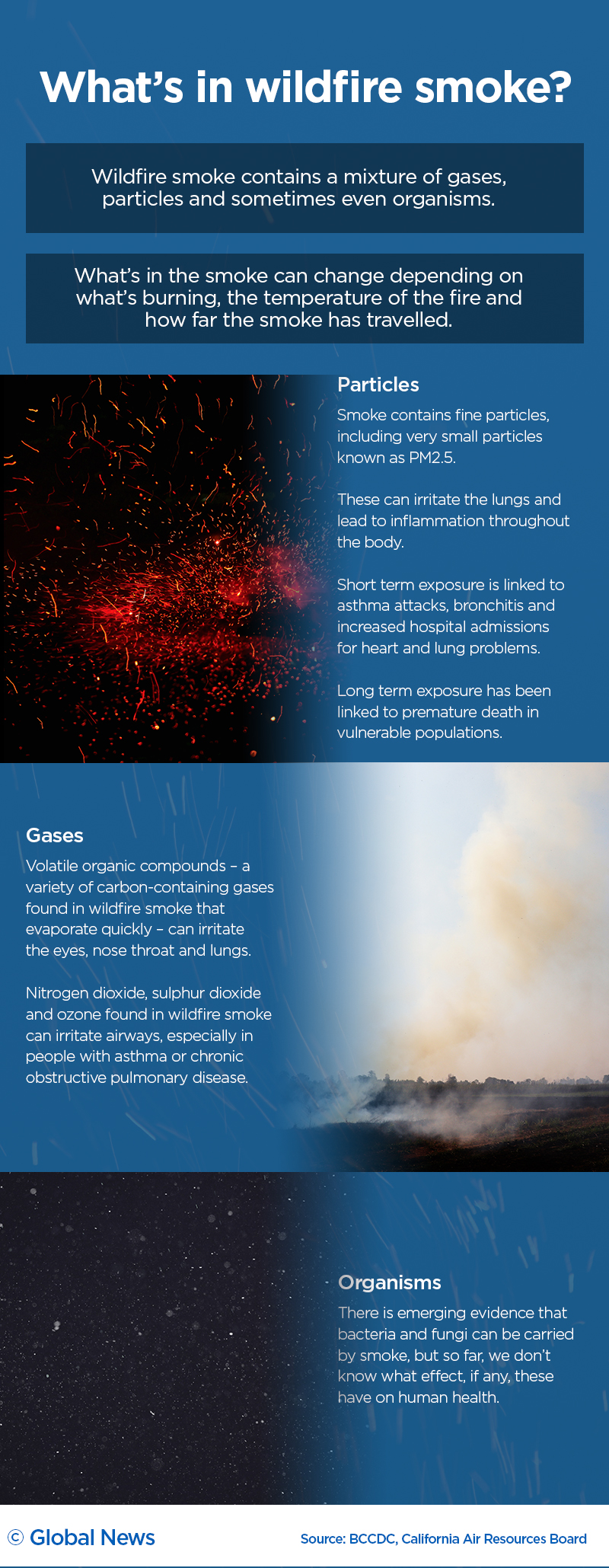When wildfire smoke blanketed Vancouver in September 2020, the effects were soon felt in the city’s emergency rooms.

“We do see it at the peak of the wildfire season,” said Dr. Don Sin, a respirologist at St. Paul’s Hospital in Vancouver. Most people who are vulnerable to smoke’s effects are extra careful, he said, but those with conditions like asthma and other lung-related issues, as well as people with cardiac diseases and pregnant women are most at risk of harm.
Wildfire smoke is known to be dangerous, but as the number and intensity of wildfires grow, scientists are closely examining the smoke — looking at what’s in it and how it might harm human health, in both the short and long term.
What's in wildfire smoke
What exactly is in wildfire smoke depends a lot on what’s burning, according to Lisa Miller, a professor at the UC Davis School of Veterinary Medicine, who has researched the effects of wildfire smoke.
“It’s not that we don’t know what should be in the smoke. It’s that it changes so much depending upon what’s being burned,” she said.
Different kinds of trees can send up different kinds of particles, for example. And when a wildfire burns houses and everything in the houses and buildings, the smoke changes again, she said.
“When you’re burning things like plastics, electronics, the chemistry of the smoke changes dramatically and can become much, much more toxic.”
Essentially, wildfire smoke contains particles, volatile gases and even organisms like bacteria and fungi, explained Sarah Henderson, scientific director of Environmental Health Services at the BC Centre for Disease Control.
The particles — especially fine particulate matter known as PM2.5 — can be inhaled deep into the lungs, where it can cause irritation and inflammation, according to the BCCDC. The gases in the smoke can irritate the eyes, nose and throat, and even the airways of people who have asthma or chronic obstructive pulmonary disease.
And then there are the living creatures found in smoke.
Some recent studies published in the ISME Journal and the journal Fire, identified living bacteria and fungi in wildfire smoke.
The researchers held up petri dishes, or flew drones over fires to collect the smoke and compared what they found with samples taken from non-smoky air, said Leda Kobziar, an associate professor of wildland fire science at the University of Idaho, and one of the authors on these studies.
Her team found more than 100 fungal species and over 900 different bacteria in the smoke.

“We’re finding all sorts of things, a lot of organisms that are known to live in soils, some that are known to live inside plants, others that live on plants and others that are common to the air, and then some that are not common to background air conditions,” she said.
“So a really wide diversity: organisms that have a variety of different types of ecological roles and have a variety of different types of potential effects on crops or on human health.”
Health effects
Kobziar said that scientists aren’t sure yet whether these bacteria and fungi found in smoke will end up being harmful to human health.
It’s clear, though, that smoke exposure has significant health effects.
A recent review found that wildfires were linked to increased ER visits for respiratory problems, asthma and COPD-related visits, more hospital admissions for cardiovascular events and even higher mortality.
Being exposed to wildfire smoke also means you’re more likely to get sick from pathogens that you encounter, according to Sin.
“When some someone inhales wildfire, the pathogens tend to stick in the lungs better. And so they’re at increased risk of respiratory symptoms, pneumonia and various complications related to these pathogens,” he said.

Researchers are also getting a clearer idea of what kinds of health effects wildfire smoke might cause long-term.
Scientists at the California National Primate Research Centre, including Miller, got a unique opportunity to study this in their monkeys over the last few years.
In 2008, Miller said, a particularly large wildfire blanketed the area in smoke. A number of infant rhesus macaque monkeys, which were housed outdoors, spent around two weeks breathing in the smoke.
After the fires, the scientists studied the monkeys closely, taking blood samples, CT scans and performing lung function tests. Three years after they were exposed to the smoke, the monkeys still showed reduced lung function.
Some of the monkeys developed interstitial lung disease, or even fibrosis, Miller said. “What this means is instead of the lungs being reactive or the airways being reactive, the lungs actually get stiff. So it makes it difficult for an individual to breathe on a regular basis.”
Monkeys who were pregnant during the wildfire were actually slightly more likely to miscarry, according to Dr. Kent Pinkerton, another researcher at the Primate Research Centre and a professor of pediatrics at UC Davis.
Monkeys aren’t humans of course, and these monkeys were actually probably more likely to show effects from smoke than humans would be, because they lived outside in the smoky air, when most people would spend most of their time indoors, Miller said. More research is needed to see whether people who were exposed to smoke had these same issues, she added.
Protecting yourself from smoke
“All of the research suggests that we will see increasingly severe and prolonged wildfire seasons, and that means increasingly severe long smoke exposures,” said Henderson.
So, she said, people and public health authorities need to be prepared.
“Go into every wildfire season expecting it’s the worst you’ve ever seen. Like, just plan that way.”
She said there are three main ways to protect people on smoky days: keeping indoor air clean, minimizing your time outside and not exerting yourself when outdoors, and using a mask.
“Individuals with pre-existing cardiopulmonary conditions when there’s wildfire should stay home,” said Sin. “Do not do strenuous exercises, do not bike, do not do any of those things. Stay indoors until the air clears up. Then, you know, then they will be in much better shape.”






Comments